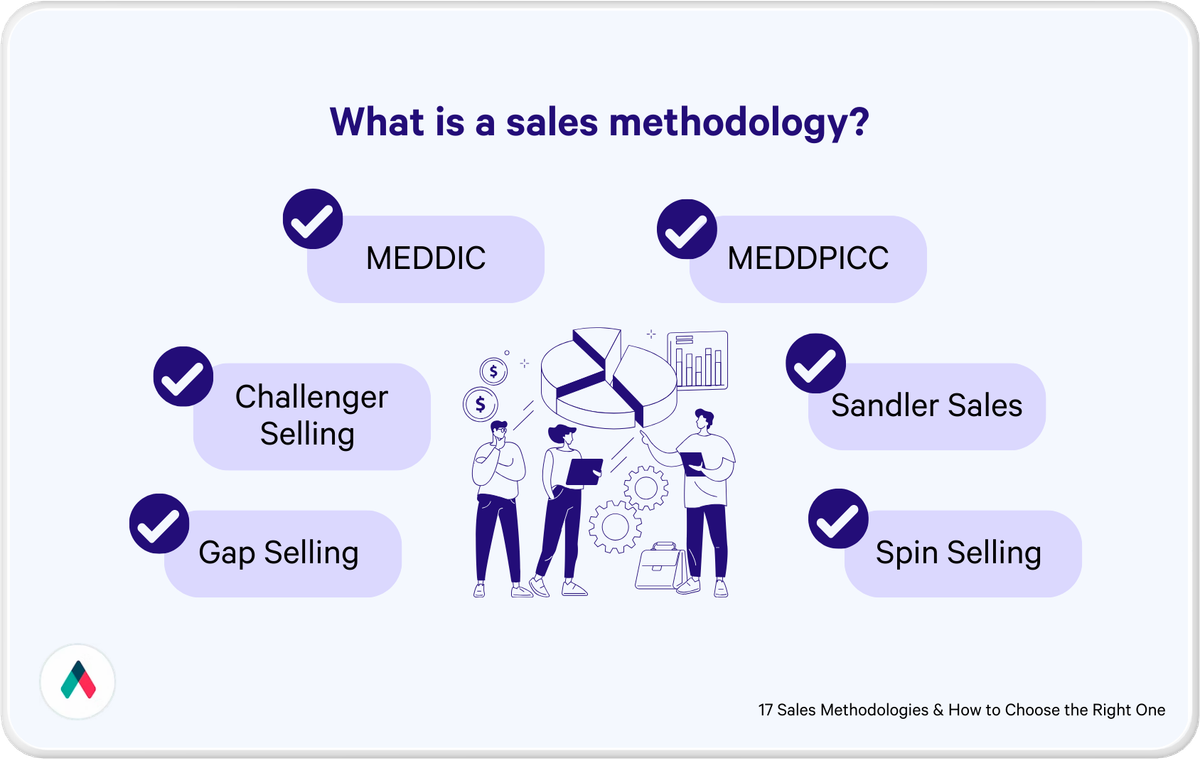For small and mid-market businesses, the struggle to secure the business - even capture the attention - of those needle-moving high-value clients is an arduous one. Outgunned by bigger names and bigger budgets, the traditional approach has been scattergun- throw all we have at the wall and see what sticks. As time has told, this is inefficient, not to mention soul-destroying and, in the rapidly evolving world of modern sales, borderline pointless.
It's time to adopt a more strategic, targeted, and thoughtful approach to sales—one focused on building relationships and delivering value.
Enter: Account-Based Sales (ABS).
This B2B sales strategy has traditionally been the domain of larger enterprises. But as we reassess how to approach sales in the 21st century, it's clear that the principles of ABS are universal. Small and mid-market businesses, too, can harness its potential to target new markets, industries, and customers with relatively low investment.
At its core, ABS is about flipping the script on sales. Instead of pursuing individual leads, it prioritizes high-value, targeted accounts/companies that align with your company's ICP (ideal customer profile). It's about deep research, personalization, and collaboration across departments to create a tailored sales strategy for each account. This approach facilitates deeper engagement, builds stronger relationships, and maximizes the chances of successful outcomes.
But ABS is more than just a selling strategy; it's a philosophy. It recognizes the need to understand each potential customer’s unique pain points, needs, and goals, and to become a trusted advisor who provides genuine value. It's about aligning your sales and marketing efforts to create a seamless and impactful customer journey. Measuring success not just in terms of revenue, but in the depth and quality of the relationships forged. Get those ducks in a row, and the rest takes care of itself.
For a small team, this may all seem pretty daunting. That’s totally understandable.
But it needn’t be. It’s just a question of the right approach and the right tools. This article will show you how.
What is account-based sales?
ABS, in essence, is a harmonization of various stakeholders to create an orchestrated and impactful customer journey targeting high-value accounts.
Perfect harmony
Imagine a symphony, where each instrument plays a crucial role. Similarly, in account-based selling, the roles are played by the sales, marketing, and customer success teams, each bringing their unique skills and expertise to the table.
Of course, you may not have the luxury of three separate teams here. Sales and marketing could be as one. You could be doing everything yourself. That’s perfectly fine (in some ways easier - the smaller the company, the better chance the left hand knows exactly what the right hand is doing!) The important thing to note here is the harmony, and - as in the symphony - an impact where the whole becomes greater than the sum of its parts.
Let’s sketch this metaphor out a little, to illustrate:
Sales is the conductor, leading the way by identifying high contract value accounts, meticulously researching their pain points, and crafting tailored sales strategies. They orchestrate initial engagement, establish relationships, and initiate the value conversation.
Marketing acts as the strings section, providing melodic messaging that resonates with decision-makers. They create personalized content, engage in account-based marketing, and offer insights that complement the sales efforts. Your marketing efforts set the tone for deeper engagement, ensuring the messaging aligns with the target account's needs.
Customer success is the percussive backbone, providing the rhythm and support that underpin the ABS methodology. A seamless onboarding process, continuous support, and building relationships for the long haul. The work here is what turns a successful sale into a lasting partnership.
Together, these functions create a holistic customer experience that surpasses traditional sales approaches. A veritable concerto of efforts, skills, and strategies resonating with the unique needs and expectations of each target account (I promise, that’s the last musical analogy).
Levelling the playing field
In a world that seeks personalization and value at every turn, small and mid-market businesses have the opportunity to harness the transformative potential of ABS as well as the larger enterprises. So long as the effort is concerted and collective, SMBs can use this same philosophy to level the playing field - delivering meaningful and enduring value, creating long-lasting relationships, and driving sustainable growth.
The relationship between account-based sales and account-based marketing
Now, you might be wondering where Account-Based-Marketing fits into all this.
Account-Based Sales (ABS) and Account-Based Marketing (ABM) are not independent strategies; they are interwoven threads in the fabric of a successful go-to-market approach. While ABS and ABM have individual mandates, they work together, relying on each other's insights and skills, to build meaningful relationships with high-value target accounts.
The role of ABS
ABS identifies high-value target accounts, maps the key decision-makers, and crafts tailored sales strategies. It seeks to build personal relationships, understand the unique needs of the target accounts, and deliver a value proposition that resonates enough to close deals.
The role of ABM
ABM complements ABS by crafting a personalized marketing strategy that speaks directly to the needs and aspirations of the target companies, utilizing content, messaging, and touchpoints that align with the insights gathered by the sales team.
The alchemy between them
The magic happens when these two forces synchronize their efforts. Salespeople provide the insights, the pain points, and the goals of the target accounts; marketing uses these insights to craft narratives that speak to these pain points, demonstrating both understanding and the ability to solve them. The result is an approach that feels less like a sales pitch and more like a value-driven conversation.
In the world of small and mid-market businesses, where resources are limited, and every opportunity is precious, the harmony between ABS and ABM can be a game-changer, by delivering a value-driven, personalized conversation.
The beauty of this approach is that it's not about the size of your business or the scale of your resources. It's about the quality of your insights and the personalization of your approach. In fact, there’s an argument that one man (or a smaller team) can deliver this approach more effectively than the bigger companies can. The united front and the personal touch are more authentic; the insights, unencumbered by groupthink or the wisdom of the crowd.
Done right, it can elevate your sales process, target new markets, and build lasting relationships with high-value accounts that may previously have been out of reach.
What are the benefits of account-based selling
The account-based sales strategy redefines the way businesses connect with high-value target accounts. When small and mid-market businesses fully embrace its power and potential, the benefits can revolutionize their sales efforts and fuel their growth.
1. Focusing on High-Value Accounts: The scattergun approach is replaced by a focus on the accounts that hold the highest potential for revenue, long-term partnership, and strategic alignment. It's not about casting a wide net; it's about targeting specific fish (or whales).
2. Building Meaningful Customer Relationships: Relationship-building is at the very core of the ABS philosophy through understanding the unique needs, aspirations, and challenges of target accounts. It's about speaking their language, resonating with their goals, and delivering value that transcends the transactional.
3. Maximizing Resource Efficiency: By focusing on high-value accounts, businesses can allocate their resources more effectively, prioritize their sales efforts, and achieve higher returns on their investment. The customer acquisition cost may go up, but it is more than compensated by the higher average deal size.
4. Enhancing Sales and Marketing Alignment: The harmony between sales and marketing efforts creates a unified front that engages target accounts with personalized messaging, tailored campaigns, and value-driven conversations. Messaging that captivates and converts.
5. Expanding Market Reach: ABS entails identifying new markets, industries, and segments that hold potential for growth. By expanding market reach, businesses can diversify their revenue streams, mitigate risks, and fuel their growth.
6. Delivering a Seamless Customer Experience: The customer experience is paramount. Creating a journey that feels seamless, personalized, and value-driven. By delivering this, businesses can elevate their brand, differentiate themselves from the competition, and create loyal advocates.
For small and mid-market businesses seeking to elevate their sales efforts, target new markets, and build lasting relationships with high-value accounts, ABS can be the catalyst that fuels their growth.
Getting started with ABS
You’ve read the manifesto, now we’ll look at how to put this all into practice.
The power of collaboration in account-based sales
For too long, sales and marketing have had a tendency to operate in silos, each pursuing their objectives and targets independently. This approach has only served to dilute the impact of both teams. In the era of ABS and ABE, the alignment between sales and marketing is not just a nice to have; it's an absolute necessity.
It's essential to understand that in the account-based selling model, the traditional sales funnel is turned on its head. Instead of starting with a broad base of leads and narrowing down, ABS begins with a targeted list of high-quality accounts and then expands efforts across multiple stakeholders within those accounts.
This reversal demands a synchronized effort in your sales and marketing to ensure that every touchpoint, every communication, and every engagement adds value to the chosen accounts. This ensures the right message reaches the right people at the right time.
As you’ll see, in this collaboration, smaller teams can often use their size to their advantage.
This requires:
Shared Understanding
The first step is to establish a shared understanding of the targeted accounts between sales and marketing. Both teams should collaboratively identify the right accounts, understand their unique challenges, and develop a holistic strategy for engagement. This is actually easier to do with smaller teams (and, of course, if you perform both functions yourself).
Unified Messaging
The alignment between sales and marketing ensures that the messaging and communication are unified and coherent. A disjointed or inconsistent message can fatally undermine the credibility of the engagement and the overall effectiveness of the approach. Again, this is a danger less likely to befall teams with smaller numbers.
Collaborative Campaigns
Sales and marketing efforts should be developed collaboratively develop, and executed to resonate with the targeted accounts. These campaigns should be tailored, personalized, and strategically timed to deliver maximum impact. Qwilr’s easy customization and automation are particularly useful here. Budget-friendly and ready to scale when you are.
Integrated Insights
If you have separate teams for sales and marketing, insights and feedback from their respective interactions with the accounts should be shared and integrated. These insights can serve to refine the approach, tailor the messaging, and optimize the engagement strategy.
Leveraging Technology
Use advanced tools and technology to track and analyze interactions with the targeted accounts. Qwilr’s sales analytics excels at this very function- tracking buyer engagement on sales collateral to what they looked at and when. These insights can provide a better understanding of the engagement, the decision-makers, and when to follow up with your leads.
Account-based sales is a journey, with collaboration at the heart of it. Sales and marketing in tandem, resulting in a powerful and impactful approach that resonates with high-value accounts and drives meaningful and sustainable outcomes.
Defining the right target audience: the key to ABS success
In ABS, defining the target audience is of paramount importance. When it comes to small and mid-sized businesses (SMBs), the process of targeting becomes even more crucial. SMBs must use their resources wisely, targeting the industries and use cases with the highest propensity to buy. Quality over quantity.
For SMBs venturing into ABS, I recommend starting small with a laser-focused approach.
1. Analyze Historical Success: Start by looking at your own past success stories. What industries or verticals have been particularly receptive to your offerings? Where have you seen higher conversion rates, shorter sales cycles, or greater lifetime value? These historical insights can serve as a reliable guide to identify the marketing with the highest propensity to buy.
2. Identify Common Characteristics: Next, look for common characteristics among your most successful accounts. These could be in terms of industry, size, geography, or specific challenges they face. Understanding these commonalities can help you create a more accurate profile of your ideal buyer personas.
(Note: Identifying markets or groups of accounts with similar industries and/or characteristics makes it easier to scale ABS. More of that in the next section.)
3. Ensure alignment: Once you have your target list of accounts, ensure your sales and marketing are aligned, both in messaging and approach. An integrated effort from your team members will create a double-whammy effect, amplifying the impact of your outreach.
4. Tailored Approach: Once you have alignment, use the insights to develop a tailored approach for each key account. Understand their unique challenges, pain points, and goals. Customize your value proposition to align with their specific needs.
5. Scale Gradually: Start small, focusing on a few high-potential accounts. As you learn and refine your approach, gradually scale your ABS efforts. Over time, you can expand your target list and go after larger, more complex accounts.
6. Iterate and Optimize: Continuously iterate and optimize your approach based on the feedback and insights you gather from your interactions with the target accounts. Be agile, be flexible, and be ready to adapt your strategy to meet the unique needs of each account. Again, you can use your size to your advantage here.
In ABS, precision matters. SMBs must be strategic in selecting their target accounts, ensuring a higher likelihood of success. Remember, it's not about casting a wide net and hoping for the best; it's about meticulously selecting the right fish and using the right bait.
Research and custom outreach: scaling with precision
Adopting an account-based approach within the same industry can be a powerful strategy for SMBs - the value proposition remains largely the same across these accounts, making it easier to scale the outreach efforts. However, customization for each specific prospect within these companies is still crucial. Here’s how to approach balancing scalability with personalization:
1. Industry Insights: Start by gathering industry-specific insights. What are the key trends, challenges, and opportunities within the targeted industry? Understand the language and the jargon that's commonly used. This will help you craft messages that resonate across multiple accounts.
2. Account Profiling: Next, dive deep into each target account. Understand their business model, their unique value proposition, their competitors, and their customers. What are their goals, pain points, and challenges? The more you know about each account, the better the qualified leads.
3. Template and Clone: Create industry-specific templates for your outreach efforts. These templates should be designed to address the common challenges and pain points of the targeted industry while enabling an added layer of personalization.
4. Prospect Personalization: Once you have your broad templates, you can delve deeper into account personalization. Within each account, identify the key decision-makers and influencers. Understand their roles, their priorities, and their challenges. Customize your messaging to speak directly to their specific needs.
5. Leverage Sales Tools: Qwilr is proposal software which makes it easy for sales teams to build custom content that can be cloned and personalized at scale - perfect for the ABS approach. Plus, with analytics, sales reps get unique insights into customer engagement so they know when to follow up and how. Qwilr also offers integrations and automations that save hours of work for both sales and marketing teams. We look at the best proposal automation software in our comprehensive guide.
Other helpful sales tools include:
- Sales enablement software
- Sales engagement software
- B2B Sales tools
- Sales productivity tools
- Sales automation software
When targeting multiple people within the same account, Qwilr enables you to share one unique link that your prospects can share with the broader buying committee. This approach simplifies the process for your prospects and ensures a consistent message, and allows you to track engagement across multiple stakeholders within the same account.
In ABS, research and custom outreach are critical. SMBs must strike the right balance between scalability and personalization. It can be a fine line to skate, admittedly. It’s about being smart, efficient, and relevant.
Prospecting decision-makers: engagement with a personal touch
Prospecting decision-makers is an art and a science, ensuring each touch point resonates, engages, and builds trust. In an era where decision-makers are inundated with cold outreach, standing out requires a personal touch.
For SMBs venturing into ABS, here's how to effectively prospect decision-makers:
- Identify Key Decision-Makers: Within each targeted account, identify the key influencers and where the responsibility for the purchasing decision lies.
- Leverage Multiple Channels: Multichannel outreach increases the likelihood of engagement and provides multiple touchpoints for building a relationship. Linkedin is the obvious starting point, but don’t ignore the potential of the other social media too.
- Engage with Valuable Content: Share engaging content that offers value. This is not about pushing your product, but about providing value and establishing your credibility.
- Personalize with Video Content: A short video where you introduce yourself, mention something specific about their company, and explain why you’re reaching out can go a long way. It shows effort, adds a human touch, and makes your outreach memorable.
- Showcase Research: Reference specific details about their company, their challenges, or their industry. This shows that you're not just sending generic outreach, but that you’ve taken the time to understand them. This builds trust and establishes you as a thoughtful, credible partner.
- Follow Up Thoughtfully: Follow up with additional value, insights, or thoughtful responses to their questions. Keep the conversation engaging and value-driven.
In ABS, prospecting decision-makers is about engagement and building relationships. You build trust by offering value, showing effort, and being genuinely interested in their needs; and that's how you pave the way for successful account-based sales.
Measure and Improve: Optimizing Your ABS Approach
In account-based sales, measuring your results and continually refining your approach is essential. By tracking buyer engagement at the account level, you can gain insights into what resonates with your target audience, tailor your follow-up, and optimize your overall strategy and sales methodology. Here’s how to approach measurement and improvement in your ABS initiative:
- Establish Metrics: Decide on the key metrics that will define success for your ABS strategy. These could include account engagement levels, the number of meetings scheduled, the progress of targeted accounts through the sales funnel, or conversion rates.
- Analyze Engagement Data: Are they opening your emails? Are they clicking on your links? Are they viewing your personalized videos? This engagement data provides valuable insights into what resonates with your target audience and what grabs their attention.
- Plan Data-Driven Follow-Up: Use the engagement data to plan your follow-up. If an account shows high engagement with a particular piece of content, reference that in your follow-up. If they’ve responded positively to certain topics, delve deeper into those in your subsequent outreach. Tailor your follow-up to reflect the interests and preferences of each account.
- Test and Iterate: In ABS, there’s always room for improvement. Test different approaches – different content formats, different outreach channels, different messaging. Analyze the results and iterate based on what works best.
- Collect Feedback: After interactions with key stakeholders, ask for feedback. What did they find valuable? What didn’t resonate? This feedback can provide valuable insights for refining your ABS approach.
- Review and Adapt: Regularly review your ABS strategy. Are you achieving your goals? What can be improved? Adapt your approach based on your results and the insights you’ve gained.
Recommendations: Small Steps to Big Success
ABS may be more typically the domain of large companies, but as a strategy, it arguably lends itself better to the personal touch and agility of smaller teams. By adopting the tips above and using the correct tools, small and medium-sized businesses can start to punch above their weight, targeting markets, industries, and customers previously beyond their reach.
So take that first step. Start small, allocating time to ABS every week, continually refine your approach, and use tools like Qwilr to help your sales team save time and scale. It’s a long-term play that more than justifies your effort.
If you’d like to see how Qwilr can support your ABS initiatives by customizing your content, tracking buyer engagement, scaling with automation and more, book a demo today.
About the author

Sarah Taylor|Senior Content Marketing Manager
Sarah leads Qwilr's content marketing efforts – specialising in field marketing, campaign planning, content, brand and communications. Sarah has both agency and global corporate experience spanning Australia, Asia and the UK.








